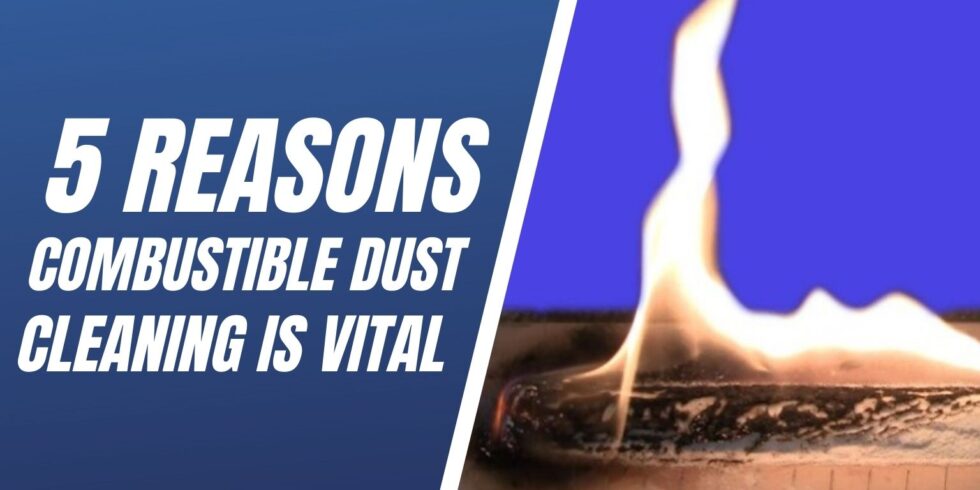
After the past two weeks of having a snowstorm, there is an important issue that is highlighted by the recent cold weather. When the temperature decreases, the danger of a combustible dust explosion increases during these winter months. A study by the U.S. Chemical Safety Board found that seven out of the eight deadly combustible dust explosions between 1995 and 2009 were during cold winter months. Therefore, combustible dust cleaning is important, especially during the winter months!
According to the National Fire Protection Association (NFPA) 654 defines combustible dust as “A combustible particulate solid that presents a fire or deflagration hazard when suspended in air or some other oxidizing medium over a range of concentrations, regardless of particle size or shape.”
5 Reasons Combustible Dust Cleaning Is Vital
-
Risk of Combustible Dust Explosion
For a fire to burn it needs three elements present simultaneously: Fuel, Ignition, and Oxygen – also known as the “Fire Triangle”. But for a combustible dust explosion, two additional elements are needed to form what is known as the “Dust Explosion Pentagon”. These two elements are Confinement and Dispersion. They are created when the fuel, in this case combustible dust, is spread out as a dust cloud within a closed area, such as a factory or warehouse. However, taking away even one of these elements can remove the risk of a dust explosion; however the risk for a fire can still be present.
Many types of dust become explosive under the right conditions, and there have been numerous cases of uncleaned dust coming into contact with an ignition source and exploding. The dust explosion pentagon has been created to explain how these explosions form and how to prevent them, and OSHA and the NFPA have been developing new codes to help combat this issue.
-
Dust Accumulating in the HVAC System
Dust can stay in the air for days, depending on its size, and over time will be brought into the ventilation ductwork as air flows through the building. The dust will begin to settle in sections of the ventilation where there is anything that might begin to snag the dust flowing past. This can lead to significant accumulations of potentially explosive dust, even if the rest of the building appears clean and safe.
Accumulated dust can pose as a fire hazard. Dust is flammable and a fire can start from a spark of energy, or an extremely hot surface. The more dust build up there is, the more chances there are for a fire to happen. According to NFPA 654, cleaning is needed immediately “whenever a dust layer of 1/32- inch thickness accumulates over a surface area of at least 5% of the floor area of the facility or any given room.” The same rule applies when it comes to cleaning a facility’s ductwork.
-
Dust Creating Quality Control Issues
Dust on the floor is a sign that there is dust elsewhere in the building, including high up and out-of-sight areas. When the dust has accumulated on high surfaces or even in the ductwork, it can be disturbed by the vibrations of the machinery below. This can cause the dust to fall onto the machinery and production equipment, creating quality control problems and even damaging the machinery.
-
Employee Health Risks and Accidents
Dust particles 2.5 microns or smaller are able to get into the lower sections of people’s lungs, where they can’t be brought up or dissolved in the bloodstream. These particles can cause health issues such as allergies, respiratory problems, lung disease, and in some cases even cancer. Even bigger pieces of dust can cause allergies and illness in workers.
Dust can also be a slipping hazard when it collects on walking surfaces; the small particles reduce the traction that people are used to when walking in a building. Slips are one of the main causes of workplace injury, and within those injuries dust is one of the main causes of those slips.
-
OSHA Fines
OSHA has been paying attention to the dangers that dust in the workplace can create and has been cracking down on companies that aren’t following housekeeping rules. The Combustible Dust National Emphasis Program was created by OSHA to deal with this issue, and has already cited almost five thousand businesses for dust accumulations, with fines ranging from thousands of dollars to hundreds of thousands.
Most manufacturing plants produce some sort of dust during the manufacturing process, and with proper cleaning it doesn’t cause an issue. The problems come when employees don’t make it a habit to clean the dust or understand the risks that dust accumulations can create.
Think you might have combustible dust that needs to be cleaned? Contact Us Here or call 888-845-3952 to fin out how Hughes Environmental can help you with your facility’s combustible dust cleaning.

